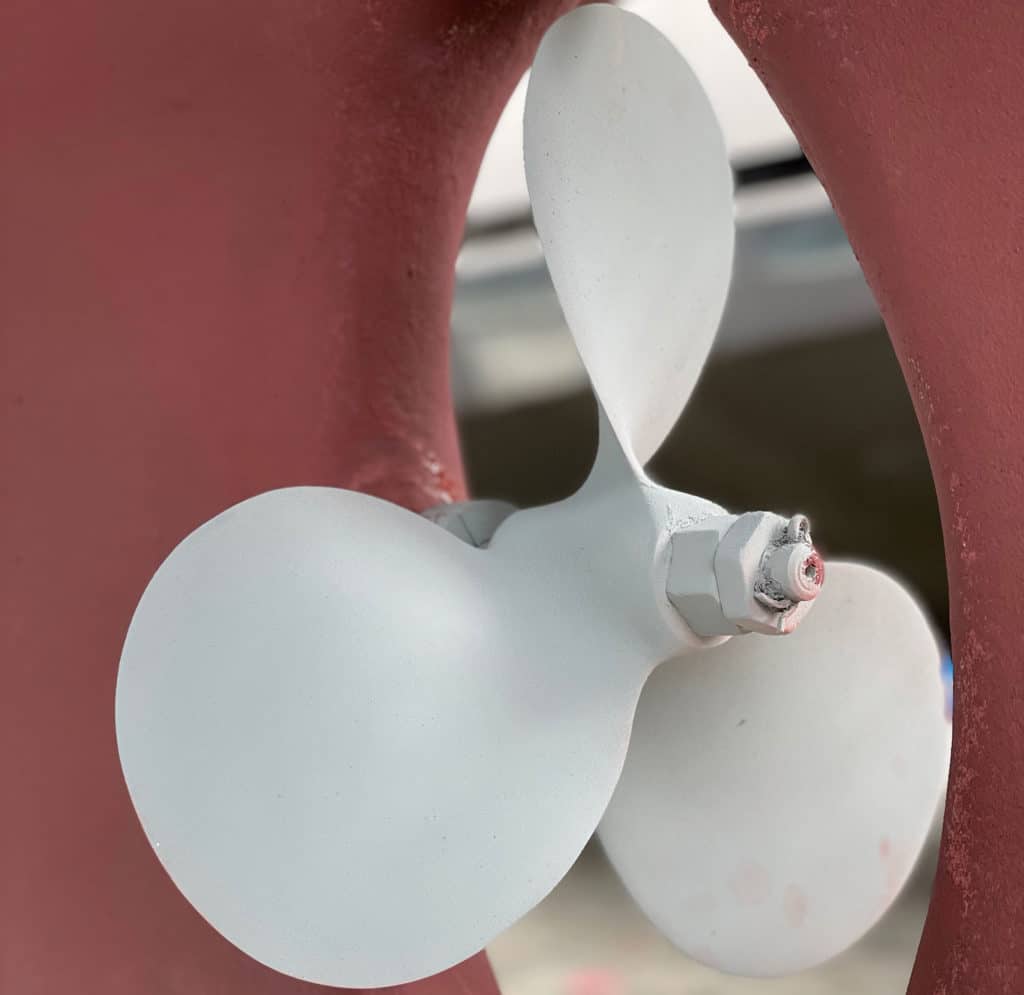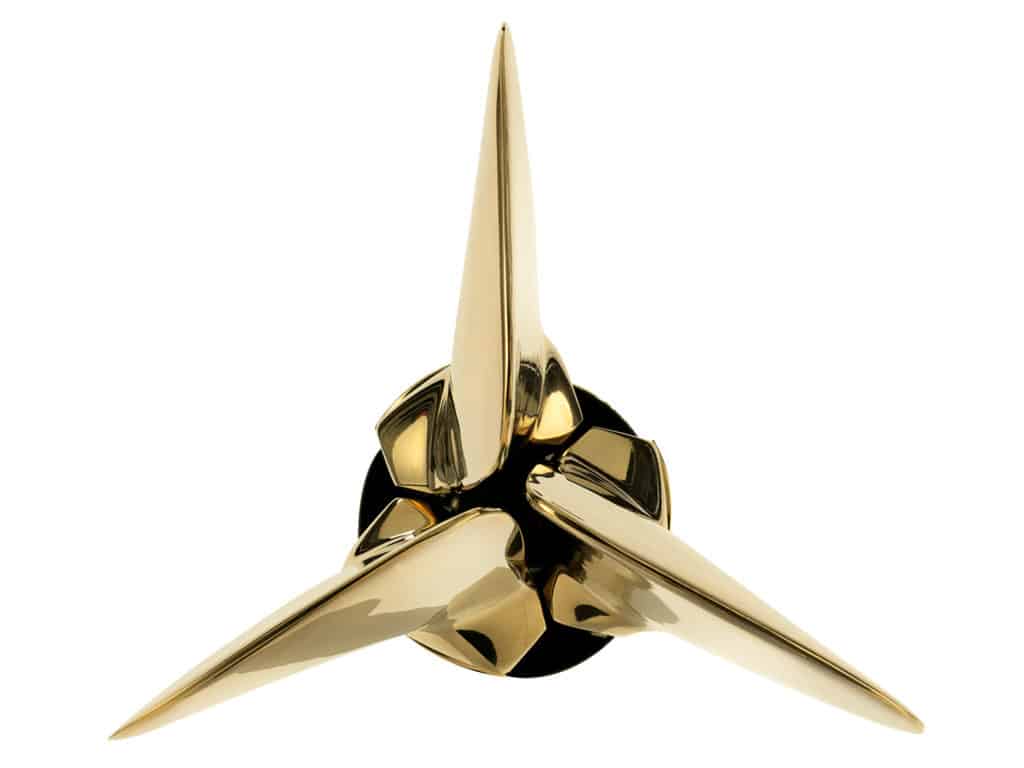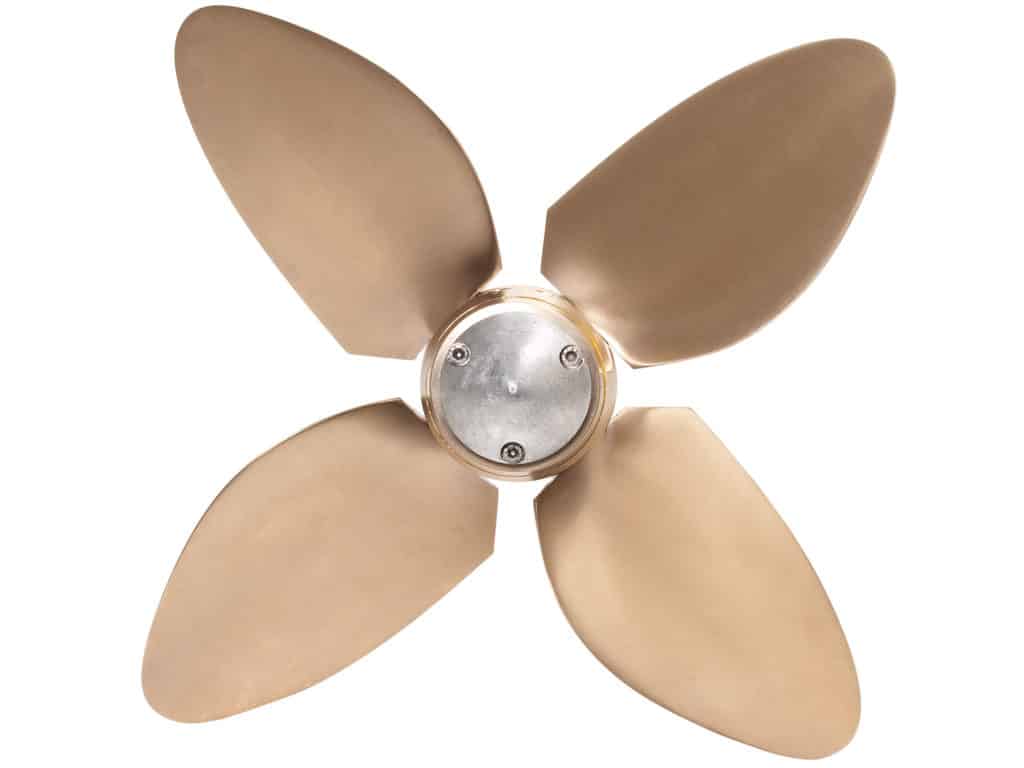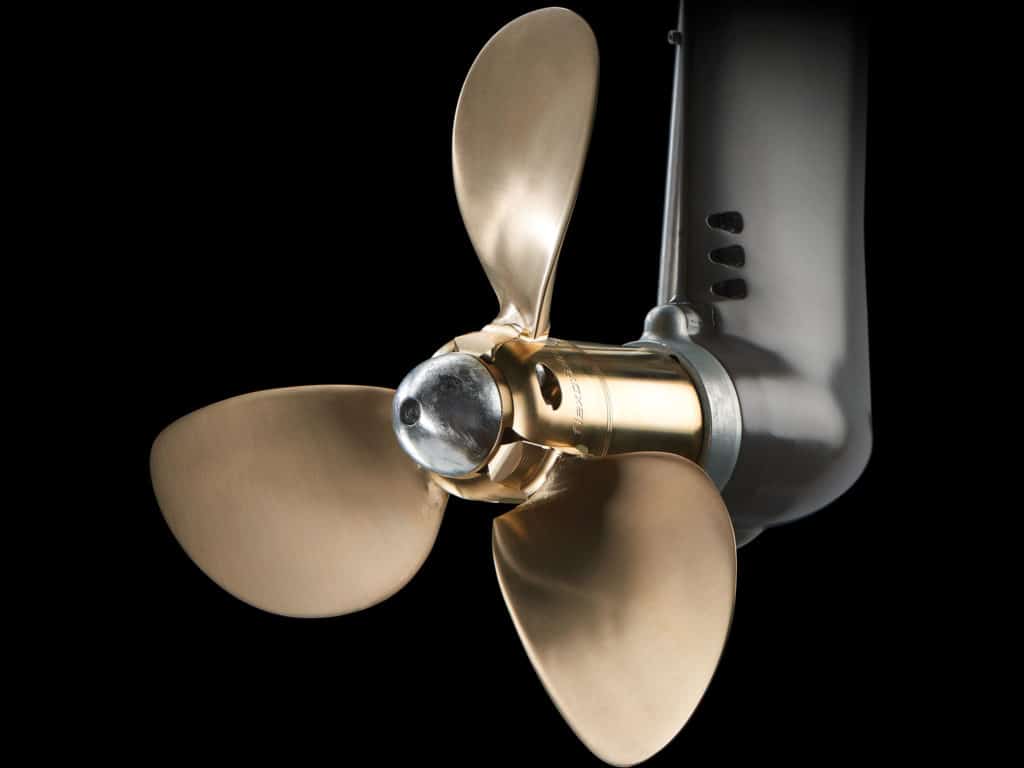
As sailors, it’s romantic to think that our locomotion comes from the wind, but most skippers, when pressed, admit to motoring a fair portion of the time. Like it or not, your boat’s propeller is a key element of the propulsion system, and just as there are myriad considerations involved when ordering sails, decisions abound when selecting the prop that best suits your wallet and sailing plans.
Fixed-Blade Options
As the moniker implies, fixed-blade propellers are typically cast out of an alloy such as manganese bronze or nickel, bronze and aluminum. Individual propeller blades stem from a central hub, which in turn attaches to the sailboat’s prop shaft or saildrive. Depending on the manufacturer, these blades typically are pitched in a way that propels the boat forward or backward when the transmission is engaged. The term “pitch” refers to how far forward or reverse a propeller will theoretically travel through a solid material (picture a screw twisting into a wood block). For example, a prop with a 12-inch pitch will theoretically move through 1 foot of solid material with each full rotation.
Sailors have choices available when buying a fixed-blade propeller, with the biggest variables being the diameter, the number of propeller blades, and the pitch. Just as sailboats create “dirty air” that spills off their sails, propeller blades push water against the hull, which then reverberates back (call this “dirty water”). When the transmission is in forward, this dirty water is sent back toward the rudder, which can influence steering. An important rule of thumb for all propeller designs and types is to ensure that the propeller has a tip clearance (the amount of space between a blade’s tip and the hull when the blade is in the 12 o’clock position) that’s at least 10 percent of the length of the prop blade (hub to tip). If you don’t have enough tip clearance, the next step is to spec a smaller-diameter propeller with an extra blade. Fixed props are available with two, three or four blades.

While this can be an easy fix, additional blades create additional drag when the boat is sailing. Because of this, sailors who opt for a fixed-blade prop are typically best served choosing a screw with the fewest number of blades that can properly fit their boat and their engine (see “Choosing Screws,” right). That said, additional blades equate to more power when motoring into a stiff headwind, current or big seas. Additional propeller blades can also accommodate a more powerful engine at a given diameter. These latter points are important if you’re planning on cruising unfamiliar waters and might find yourself negotiating a lee shore under power.
While fixed-blade propellers are strong, simple, relatively inexpensive, and easier to have repaired in remote locales, they do affect sailing performance. Moreover, they’re more likely to foul a lobster pot or other fishing gear than a folding prop when the boat is sailing. If you care about sailing performance, especially in the light stuff, or if you’re planning a long-distance cruise, purchasing a folding or feathering prop is a wise investment. But if you’re seeking maximum power or punch for your buck, and you sail on breezy waters such as San Francisco Bay, where extra drag isn’t a huge concern, a fixed-blade prop could be the way to go.
Folding Propellers
Folding propellers employ a series of gears (situated around the prop’s central hub and on the inboard end of each prop blade) and centrifugal force to open when the engine’s transmission is engaged. The slipstream action of the passing water acts to fold them closed when sailing, and their gear mechanisms hold the blades in their closed position even in light airs. As with fixed-blade props, sailors can choose between models that feature two, three or four blades. Unlike fixed-blade props, however, folding propellers create far less drag when the boat is sailing.
“For the same diameter and number of blades, folding propellers have 85 to 100 percent less drag than a fixed prop, depending on the fixed propeller’s blade area and the folding propeller’s make and model,” says Geoff Prior, owner of AB Marine, the Newport, Rhode Island-based importer and distributor for Gori folding props and AutoProp, Variprofile, and Variprop feathering propellers. “Geared folding propellers stay closed or folded when the boat is sailing, so a blade cannot drop down to be exposed to the water flow, and does not catch lines and weeds like fixed and feathering propellers can.”
Others agree. “Most sailboats will gain 0.5 to even 1 knot of speed by using a low-drag folding propeller,” says Keld Willberg, Flexofold’s general manager. “Many boat owners don’t look just at the speed gains, but also the ability to sail in very light wind.” Also, he says, when tacking, a boat that’s equipped with a low-drag prop won’t lose as much momentum.
This latter point is critical to anyone who sails in places with typically light breeze. “The folding propeller’s drag reduction and increased sailing speeds produce less turbulence over the rudder, enabling you to point higher, steer easier and more precisely, and tack and jibe the boat easier,” Prior says. “The biggest speed difference is in light or medium air and with clean water flow over the rudder—the boat is a lot more responsive, especially when fine sailing on the wind.”

One important consideration when selecting a folding prop is ensuring that your boat can physically accommodate the length of the prop when it’s folded. This is especially important on full-keel boats that have an aperture between the keel and rudder. For anyone who cruises with a saildrive(s), Prior advises that saildrive propellers must be approved for use by the saildrive’s manufacturer to ensure that the prop is electrically isolated from the saildrive’s leg and shaft; also the prop’s hub must incorporate a rubberized bushing to absorb shock and inertia, as well as an easily changed and streamlined anode.
As with all props, selecting the diameter, number of blades, and pitch of the propeller are all key decisions. “Diameter is the single most critical factor in determining the amount of power that a propeller absorbs and transmits into the water,” Prior says. “It’s the most important single factor in determining the amount of thrust delivered. The larger the diameter, the greater the efficiency. A small increase in diameter dramatically increases thrust and torque load on the engine and shaft.”
Blade count is also critical, but Willberg cautions that it’s overly simplistic to think that additional blades equate to additional power (see “Calling the Pitch,” right). “What matters is to get the right combination of blade area and pitch for the engine and gear box,” he says. “On flat water, a two-blade propeller can be just as efficient or even slightly better than a three-blade. However, when motoring against wind and waves, and when maneuvering, you get more power from a three-blade prop.”
Blade shape also matters. “Propellers with flat, planar blades are like a paddle,” Prior says. “The flat shape is not efficient at producing thrust because a flat blade is overloaded at the tip and underloaded at the blade base, whereas a fully shaped airfoil blade shape has a constant loading over its whole surface.” Much like fixed-blade props, most folding propellers employ an efficient blade shape, while feathering props use flatter and more planar-shaped blades.
One drawback of most (but not all) folding props emerges when the transmission is put into reverse. “In reverse, the suction side is on the back or aft side of a blade, and with the typical folding propeller design, the blades are trying to close in reverse, giving low thrust and lots of prop walk,” says Prior, who added that Gori’s three-blade prop presents identical leading-blade edges in both forward and reverse, negating this issue. Willberg advises that folding props require slightly different operation than fixed-blade or feathering props to ensure that they stay open. “For more stopping and reverse power, it’s just a matter of giving more revs on the throttle,” he says.
RELATED: Understanding Your Sailboat Propellers
As with all props, folding propellers must be kept clean of marine growth, and anodes must be regularly changed to ensure cathodic protection. “One millimeter of growth on a blade and your propeller loses approximately 12 percent efficiency,” Prior says, adding that this applies to any make, model or design. And, he notes, “folding propellers are water-lubricated, so they do not need to be greased.”
The final consideration is cost. Folding props are roughly four to six times more expensive than a fixed-blade propeller for a given diameter and blade count. While this is a big difference, the gains are huge, and—for bluewater cruisers—can translate to significantly faster passage times (potentially measured in days) and happier crews.
Feathering Propellers
As do folding propellers, feathering props greatly reduce drag when the boat is sailing; however, the way that they achieve this gain is significantly different. Moreover, the physics behind how the prop transitions from its sailing mode to motoring mode is also different.
Feathering props are available with two-, three-, four- and five-blade configurations. A central hub attaches to the prop shaft or a saildrive, and it features a series of internal beveled gears. Geared propeller blades attach to the hub and rotate through 180 degrees, depending on if the transmission is in forward or reverse (more on this later); this articulation is governed by machined stops inside the hub that prevent the blades from overrotating. When the transmission is engaged, the blades present their broad sides to the slipstream, but when the boat is under sail, the blades rotate 90 degrees to align with the flow of the water.
“Feathering props work off torque from the shaft or saildrive,” says Fred Hutchison, at PYI, which distributes Max-Prop feathering propellers. Because feathering props use torque—not centrifugal force—to open, it’s “instantaneous,” says Hutchison, who points to this as the design’s biggest advantage. “It takes a feathering prop only three-quarters of a turn to go from full forward to full reverse. In that time, the blades rotate 180 degrees, and it doesn’t generate much shock load.”

Prior adds, “In the sailing position, the water flow turns the blades to the feathered position when the engine is off for vastly reduced drag.” He estimates that this drag reduction is approximately 85 percent compared with fixed-blade props.
As previously mentioned, feathering-prop blades rotate through 180 degrees, which is a big advantage when operating in reverse compared with most folding props. “A feathering propeller gives reverse thrust with the same efficiency as in forward, as the leading blade edge in forward is turned 180 degrees, and without prop walk,” Prior says.
Another advantage of feathering props for boats with full keels or with tightly spaced skegs or rudders is that they “can fit in a small aperture as they have shorter overall lengths compared to folding propellers, which have a greater length when folded,” Prior says. “If there is a diameter constraint, the feathering prop can easily be designed and built with a higher pitch to make up for the loss of diameter and blade area.”
Most feathering props are machined out of a nickel, bronze and aluminum alloy, which, Hutchison says, makes them easy to repair. Unlike fixed or folding propellers, feathering propellers employ flat-shaped blades to reduce drag when the boat is sailing. “Feathering propeller blades are foiled and aren’t as efficient as the helical twist found on most fixed-blade or folding props,” Hutchison says, adding that manufacturers compensate for this less-efficient shape by increasing each blade’s surface area. “Blade surface area and shape make a big difference in how efficient it is,” he says. “No low-drag prop will be as efficient under power as a fixed-blade propeller.”
Lobster pots and fishing nets are common concerns when operating under auxiliary power, and feathering props are not snag-proof. “When motoring, feathering props are the same as fixed-blade and folding propellers,” Hutchison advises. “But when sailing, a folding propeller has less of a chance of catching a pot or fishing net than a fixed-blade or feathering propeller.” This is a consideration for anyone who cruises extensively in, say, Maine or in heavily fished waters off the West Coast.
As with all propellers, feathering props require basic care and maintenance to ensure their efficiency and the engine’s longevity. This starts with a properly spec’d and regularly refreshed anode, and the prop blades must be kept clean.
Unlike folding props, which typically use exposed self-lubricating gears, the internal gears of feathering propellers need to be greased annually. While this adds an item to an owner’s yearly to-do list, Hutchison says that this can be tackled by a diver.
Finally, while feathering props are a great upgrade, they don’t come cheap. “Feathering props are more expensive than folding props,” says Hutchison, who advises that a feathering prop is roughly 10 to 15 percent more expensive than a folding prop with the same blade count and a comparable diameter. “This is primarily because of machining costs,” he says.
David Schmidt is CW’s electronics editor and also writes about topics ranging from sailing gear to environmental issues from his home in Bellingham, Washington.
Choosing Screws
Choosing the right propeller is complex, but the most important variables for selecting the correct prop are your boat’s make, model, LOA and displacement, the engine’s horsepower rating and its maximum rpm, as well as the transmission’s reduction ratio. While most of this information is easily ascertained, determining the reduction ratio can be challenging. But, Prior says, “the best method to get the actual ratio is to use your cellphone camera and take a photo of the plate on the transmission,” adding that this beats hanging upside down and trying to read this information using a mirror and flashlight. For the DIYer, online calculators exist that can help crunch the numbers. “After that, it gets into the art,” Hutchison says. His advice: Ask an expert.
Calling the Pitch
Unlike fixed-blade propellers, feathering and folding propellers are often designed so that the pitch can be adjusted, perchance it doesn’t perfectly match your vessel, engine and transmission right out of the box. Depending on the prop, this adjustment is typically made by changing a screw(s) or swapping out the prop blades. These adjustments can usually be done by a diver while the boat is in the water. Some general rules of thumb as to when to change the pitch involve engine rpm: If the prop doesn’t meet the engine’s ideal rpm, the blade’s angle needs to be reduced; conversely, if the prop is exceeding the engine’s rpm metrics, the blade’s angle of attack needs to be increased. As a cautionary note, overpitching a propeller can cause the engine to overheat, and it can also lead to injector-choking problems and create excessive internal engine pressure, so be sure to stay within the engine manufacturer’s lines.
Vendor Information
EWOL: ewoltech.com, 410-317-8104; from $2,120
Flexofold: flexofold.com, 781-797-0809; from $980
GORI: gori-propeller.com, 401-847-7960; from $650
J Prop: betamarinenc.com, 252-249-2473; from $2,500
Kiwiprop: kiwiprops.co.nz, 877-549-4872; from $1,350
Max-Prop: pyiinc.com, 425-355-3669; from $1,900
Michigan Wheel: miwheel.com, 800-369-4335; from $550
Variprofile: spw-gmbh.de, 401-847-7960; from $800
Variprop: spw-gmbh.de, 401-847-7960; from $1,200
Volvo: volvopenta.us, 800-522-1959; call for pricing








